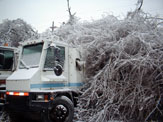|
KENTUCKY BLUEGRASS ON ICE - 2003
INITIAL ICE STORM ICE STORM DAMAGE ICE STORM TIMELINE
FEBRUARY 2003 . . . PHOTOS (C) 2003 Mark D McKinley - Fujifilm FinePix A101 1.3MP
Ice Storm Freezes the Bluegrass
TIMELINE OF THE ICE STORM
February 15, 2003 - Late night freezing rain moved into Kentucky, leaving behind over an inch of ice in many areas. Utility poles, power lines, trees and branches snapped under the weight of heavy ice.
February 16, 2003 - Resulted damage and the massive power outages led utility companies to categorize ice storm as catastrophic. 117,000 customers in Kentucky were without electrical power on February 17th. At any given time there were as many as 65,000 customers experiencing power outages in the city of Lexington and adjacent counties. Motels and Hotels were filled to capacity. Many people were left to seek shelter in nearby cities. 200-400 people stayed in emergency shelters.
Kentucky Utilities Company formally requested assistance for additional manpower and equipment from around the state to expedite repairs. A few other states also sent electrical crews to Lexington to assist in the major repair effort.
February 17, 2003 - Tree limbs and utility poles continued to break and restoring electrical power was extremely difficult. At times, power would only momentarily be restored before falling debris would disrupt the service yet again. 600-700 people stayed in emergency shelters. City officials had 17 pages listing road closures due to downed electrical wires, debris, etc.
Relief supplies such as flashlights, batteries, etc. were brought in from as far away as Texas. Building supply and hardware stores ordered overnight shipments of generators, kerosene heaters, kerosene, lamp oil, candles, batteries, etc. Over 24 hours after the storm, 40 intersections remained without working traffic signals. $80,000.00 had accumulated in overtime hours in the first 30 hours of the winter disaster.
February 17, 2003 (2:45pm) - 56,000 customers remained without electrical power. 47 counties and 29 cities in Kentucky declared emergencies due to flooding and ice related problems. 3 water treatment plants were down due to power outages and main breaks. 100 utility poles were now broken in the city of Lexington.
February 18, 2003 - Approximately 50 intersections did not have functioning traffic signals. 800 workers were now attempting to reestablish electrical service. 48,000 customers remained without electrical service. 570 fire runs had been made by fire departments since the icing began. Several people were treated for carbon monoxide poisoning due to using improper heating devices. At this time no storm related fatalities have been reported.
In 1994, a similar, yet slightly milder ice storm took 7 days to completely restore electrical service. The 2003 event would likely require several days beyond that. 50 National Guardsmen were brought in to work with utility companies and the Public Works department. They assisted with debris removal, etc., including Humvees and dump trucks. Guardsmen also supported police with nonfunctioning signals at busy intersections. An electrical crew from Mt. Aries, North Carolina was assigned to our community.
February 19, 2003 - The morning and afternoon hours brought freezing rain, sleet, even snow. Accumulations were insignificant, yet the precipitation further hampered electrical workers. 32,000 customers were still without electrical power. Approximately 33-39 traffic signals remained nonfunctioning at intersections. 1,000 restoration workers were on the ground, working shifts around the clock. Kentucky Utilities had coordinated 360 bucket lift trucks, which brought the total of vehicles on the road assisting with power restoration to 440.
February 20, 2003 (am) - Electrical contractors worked around the clock trying to restore power across the bluegrass. 50 plus hours after being dispatched to our neighborhood, a North Carolina crew had restored electrical service to our community and we returned home. The temperature reached 50 degrees and the big thaw began. The sound of cracking tree limbs crashing to the ground, and the sound of chain saws managing debris, were replaced by sounds of falling ice. 17,000 customers are still without power, and numerous roads remain closed due to sagging or broken power lines. Several intersections are still being manned by police and National Guardsmen due to power outages.
February 20, 2003 (pm) - 22,000 customers continue to experience power outages as more problems develop.
Five days after the ice storm, the number of intersections without working traffic signals climbs yet again, totaling 61.
February 23, 2003 (pm) - 7,000 customers remain without electrical power. 3 intersection traffic signals are still not functioning. One storm related fatality has now been reported.
February 27, 2003 (pm) - Most homes have now had their power restored.
Mogs Website Design, Logos, Photography Copyrighted 1999-2014 Mark D McKinley
|





















